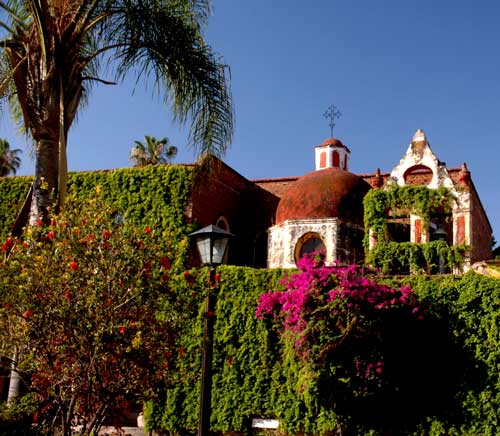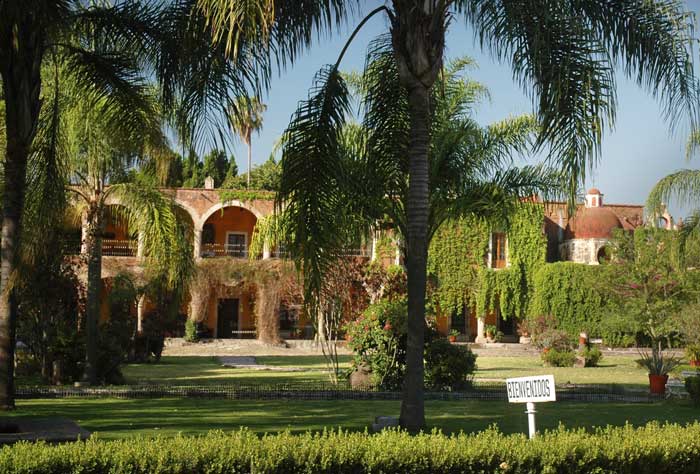|
By John Pint
 I
am writing these words on a comfortable
sofa inside one of the magnificent arched porticos of Hacienda
El Carmen, which is located only 50 kilometers due west of
Guadalajara and reachable in an hour and a half from Lake
Chapala. Hundreds of turtle doves, great kiskadees, grackles and
robins are singing in the huge rubber tree shading the courtyard
in front of me, while the soothing melodies of Antonio
Bribiesca’s guitar play in the background. I
am writing these words on a comfortable
sofa inside one of the magnificent arched porticos of Hacienda
El Carmen, which is located only 50 kilometers due west of
Guadalajara and reachable in an hour and a half from Lake
Chapala. Hundreds of turtle doves, great kiskadees, grackles and
robins are singing in the huge rubber tree shading the courtyard
in front of me, while the soothing melodies of Antonio
Bribiesca’s guitar play in the background.
This venerable hacienda is now a hotel, a spa, a gourmet
restaurant and a historical monument all in one. This morning we
had the pleasure of breakfasting with Mónica Baeza who grew up
in the hacienda and in 1996 took charge of running it. We were,
of course, curious about the history of the place. When we asked
Mónica about it, her eyes lit up.
“Would you believe that this hacienda was built by Carmelite
monks? It dates back to the 16th century when the Spanish Crown
bequeathed the land to one Francisco Merodio de Velasco. It
stayed in the family for generations until around 1705, when
Francisca Figueroa, a widow with no children, decided to give it
to the monks, who, in fact, are the ones who constructed the
main buildings and that beautiful courtyard out there. The
Prior, however, did not want to turn it into a monastery.
Instead, he sent the earnings from the cattle and crops to
Guadalajara to finance the construction of the famous Convento
del Carmen. Back in those days, this finca (farm) was
huge. It had 22,000 hectares on which they produced corn, wheat,
oats, sugar cane, mezcal and sorghum, just to name a few things.
“Now, along came Benito Juárez and the Reforma. As a result, the
Carmelites were expelled around 1856. The Ley Juárez relieved
the Catholic Church of all its properties. So the Convento del
Carmen suddenly became the Ex-Convento del Carmen as it is known
today and our hacienda fell into the hands of people who were
rich and powerful back in the days of Juárez. After that, it had
many owners until it suffered from neglect and was auctioned
off.
“In 1964 my mother fell in love with the old place and our
family bought it and developed it as a country house. So this is
where I grew up, where I played with my friends. Then, in 1996,
when my father became ill, we held a family meeting to decide
what to do about the hacienda. Well,
I ended up in charge of the place, because I raised my hand and
said, ‘I’ll do it’.”
Today Hacienda el Carmen has “only” 160 hectares of farmland
where they raise sugar cane and corn and specialize in growing
large, beautiful bell peppers for exportation.
Mónica Baeza’s degree is in Industrial Relations and her
principal hobby has long been cooking. When asked how she feels
about being a farmer, she sighed. “Agriculture,” she stated,
shaking her head, “has more variables than any other business.”
In fact, she decided to transform the hacienda into a hotel in
order to help balance things out economically. As for running a
hotel-spa, Baeza discovered that “La hotelería is the
business of perfection. Everything must be done perfectly from
the very first contact with the client until the moment you wish
your parting guest a safe journey—you can’t push the rewind
button.”
“In the end,” she adds, “our hacienda has become una fábrica
de amigos, a factory that makes friends.”
Indeed, the extraordinary friendliness of every soul we met at
Hacienda El Carmen, whether owner, waitress, gardener or
gatekeeper, made us feel completely at home. Human warmth is
perhaps Mexico’s most important attraction, but it is not always
encountered in hotels. This hacienda, however, is filled with
good vibrations and we even made friends with the ducks and the
horses. Truly, “una fábrica de amigos.”
What can you do at the hacienda? Plenty. Just start wandering
and you’ll come across cool, shady courtyards with bubbling
fountains, wide, wide, stretches of green (including a six-hole
golf course), the remains of a long, graceful aqueduct and a
small lake where you can go swimming and bathing with the ducks
or try sneaking up on the iguanas sunning themselves along the
shore. Wherever you go, whatever corner you turn, you’ll run
into relics of the hacienda’s long history, now tastefully
transformed into objets d’art, whether old wagon wheels,
brightly colored ceramics, ancient paintings or even a life-size
wooden statue of St. Francis of Assisi, dating back to the days
when brown-robed monks glided along the corridors.
Big attractions, of course are the massages, Jacuzzis, facials,
etc. for which the hacienda’s spa is now famous. There are also
all kinds of “little attractions” everywhere you turn:
monogrammed towels, bathrobes and slippers, a shower as
plentiful as Niagara Falls, chirping crickets under a huge night
sky with unimaginably bright stars, the kind of sky you can only
find far away from the hustle and bustle of the city.
And then there’s the food. It is simply perfect. Even if you
can’t stay overnight, it would be well worth it just to come for
one of these gourmet meals. On top of that, they even have their
own “house tequila” called Alebrijes, which is aged right on the
grounds.
To me, the most surprising thing about Hacienda El Carmen is
that they are not charging a fortune as are so many other
haciendas. During the week, the price for a double room is US$
130. This price does not include breakfast or spa services, but
it does get you on the grounds and allow you to enjoy the place.
If you’re interested in visiting Hacienda El Carmen, take a look
at the Calendar on their
website. They
have special events like musicians in the moonlight on certain
nights or imaginative discounts. For example, “Scorpios get a 50
percent lodging discount from November 4 to 6, if they bring
along their birth certificate and anyone named Lupita
(Guadalupe) gets a free back massage between Dec. 9 and 12,
again with birth certificate in hand. You can see for yourself
how beautiful this venerable landmark is by checking out my
video on YouTube.
How to get there
From Guadalajara: Take Avenida Vallarta and then highway 15
(Nogales and Tepic) west for 25 kilometers to highway 70 which
heads southwest towards Ameca. Now go about 18 kilometers and
you’ll come to an overpass and turnoff to Tala. From Ajijic:
Take the Circuito Sur from the airport road (Cajititlán-Tlajomulco-Tala)
to the same overpass. Now go 1.4 kilometers west where you’ll
see a huge sign reading El Refugio and a much smaller but far
more important sign saying Teuchitlán. Turn right and drive 13
kilometers to Teuchitlán. Keep going west another 6 kilometers
and turn left at a sign reading Hacienda El Carmen. After
another 9.5 kilometers you’ll see the Hacienda on your right.
Driving time from Guadalajara’s western Periférico is one hour
and from Ajijic (via the Circuito Sur) it’s just one hour and a
half.
Parts of this article first appeared on
Mexconnect, where you can see many more pictures of this
beautiful hacienda.

|

